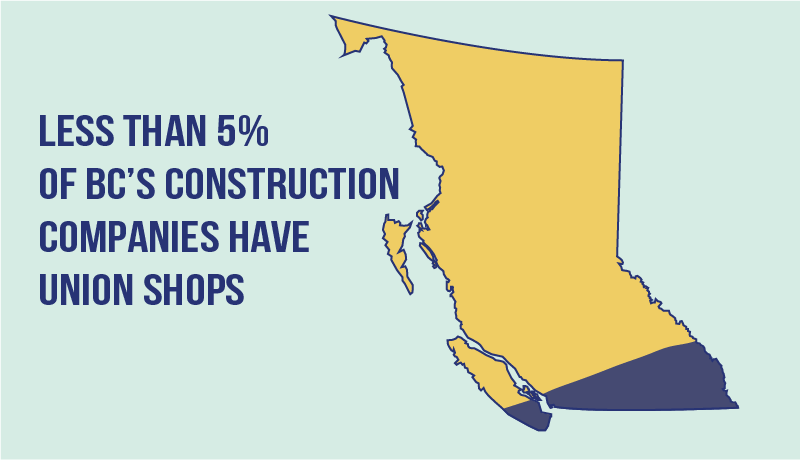The BC Construction Association proudly represents both open shop and union construction employers in BC’s industrial, commercial, and institutional construction sector. We are unique in this non-partisan role at the provincial level, and as such we play an important role as the “voice of reason” on key industry issues such as prompt payment, community benefit agreements, safety, and apprenticeship training. Our role is to carefully consider the needs and objectives of the sector as a whole, respecting and balancing the demands of different types of employers and elements of the workforce.
Increasingly over the past few years the BCCA has turned to statistics and data to clarify discussions as we advocate for a productive and resilient sector.
We turn now to data points that can help us understand the role of unions in BC’s construction sector. This understanding is crucial to ensure that our provincial economy stays strong over the coming years, especially as we continue to face significant skills shortages in an industry contributing nearly 10% of BC’s GDP.
The BCCA position is that there is a role for both union and open shop employers: it will take the full workforce working together in every community of BC to deliver the projected $325 Billion in construction projects.
Unions in Construction
Construction has a relatively low union density of 13%.
The only sector less unionized than construction are business, professional services and finance.
About 33,000 of BC’s construction workers are unionized, of 251,707.
Large companies of 100 employers or more are 10x more likely to be unionized than small companies.
90% of BC’s construction employers are small (10 employees or fewer) and are less likely to be unionized.
We estimate approximately 1200 construction employers operate union shops, out of 23,347 companies.
Demographics
Trending shows that youth aged 17-24 are 50% less likely to be unionized than they were in 1981.
Women are the only demographic group as equally likely to be unionized now as in 1981.
Outcomes in Construction
Very often, unions will advocate for union employers to receive preferential treatment in public procurement on the grounds that they deliver greater benefit to their employees and communities. The BCCA has been seeking data that validates these claims:
- Safety – there is no data to show that unoin ships have better safety outcomes than open ships. This data is not tracked, and not reported. Today;s construction employers take pride in their safety records, and increasing transparency of outcomes holds everyone equally accountable. For reference, please refer to a recent in – depth study from Ontario: Protecting Construction Worker Health and Safety in Ontario
- Apprenticeship – there is no data to show that union shops have higher apprenticeship ratios than open shops. This is data is not tracked, and not reported.
- Prompt Payment – there is not data to show that union shops pay more promptly than open shops. This is data is not tracked, and not reported.
- Wages and Benefits – the compensation gap between union and open shop employers has shrunk to be only negligible, as the demand for skilled tradespeople has increased and as workers have new access to information via the internet and other communication tools. Competitive acquisition and retention strategies are essential in this new market. BCCA Wages and Salaries Survey
Conclusion
The public sector, at a union density of 80%, is BC’s most powerful union sector. The private sector has a predictably low union density, and construction is reflective of that. While unions play an important role in supporting safety and apprenticeship, most open shop employers are equally dedicated to these outcomes and today’s market forces continue to ensure that all employers provide competitive compensation packages. With a skills gap of 14,000 workers predicted for our province it, it is essential that all construction employers, regardless of their union status, be equally considered for public sector projects. True community benefit comes from prioritizing inclusion and access to opportunities for the workforce as a whole.
Our Union Stat Pack is a summary of the key statistics and trends from the BC construction. For more information, the Labour Force Survey details be can retrieved from Statistics Canada here.




